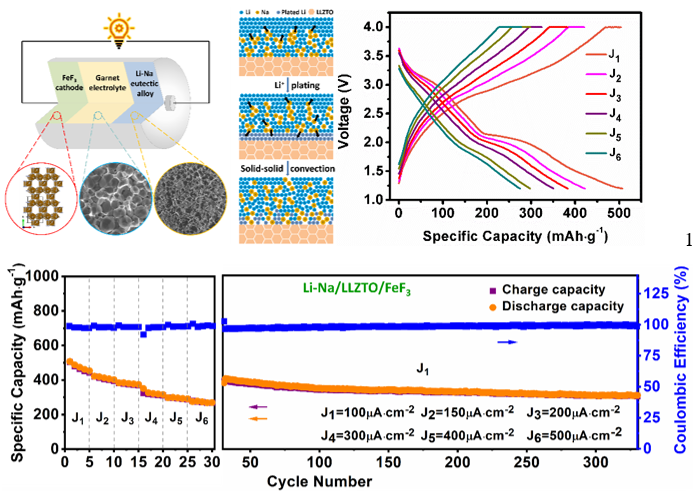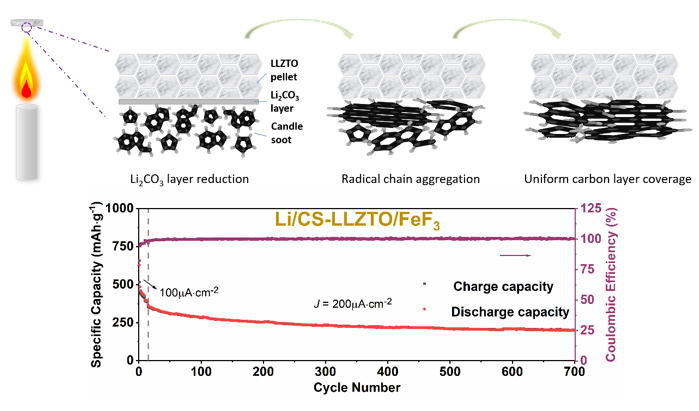Ceramic based solid-state Li-fluoride conversion batteries benefit from interfacial activation with superior wettability
Compared with traditional lithium ion batteries (LIBs), lithium metal batteries (LMBs) have the potential advantage of high energy density in view of the use of Li metal anode with ultrahigh theoretical specific capacity (3860 mAh·g-1) and lowest electrochemical potential (-3.04 V vs. standard hydrogen electrode). For LMBs, apart from traditional Li-containing polyanion frameworks and layered oxide materials, emerging Li-free fluoride materials with higher theoretical energy density can also be adopted as cathodes. Liquid electrolytes are used as the Li-ion transmission medium in general LMBs, and they usually contain Li salts and organic solvents. Due to the side reactions of liquid medium and the flammability of organics, this type of battery has certain safety risk. Replacing the liquid electrolyte with solid-state one as the Li-ion conductor can improve the safety and stability of LMBs and expand the temperature range of LMB operation.
Garnet-type doped Li7La3Zr2O12 (LLZO) emerges as the candidate oxide solid electrolyte because of its high Li-ion conductivity at room temperature (up to 10-3 S·cm-1 at state-of-art), stability against Li metal, and facile synthesis process with economic raw materials. However, LLZO still suffers from some disadvantages when contacting with metallic Li: (1) LLZO is unstable when exposed to air, and Li2CO3 and LiOH passivation layers form on the surface of LLZO. They would degrade the wettability of Li on LLZO substrate and the corresponding Li/LLZO interfacial impedance. (2) The limited contact area between Li and irregular LLZO grains would make the current distribution inhomogeneous, leading to selective Li mass deposition on the LLZO surface and even rapid Li dendrite growth along the grain boundaries of LLZO. These factors would cause a quick degradation of voltage polarization performance or electrochemical failure and even short circuit in LLZO-based solid state LMBs (SSLBs). Thus, it is quite urgent to explore proper strategies to modify the anode/ garnet interfaces.
Recently, the research team led by Professor LI Chilin in Shanghai Institute of Ceramics, Chinese Academy of Sciences, has made a series of progresses in the interface modification of ceramic-based solid-state electrolytes and the performance activation of corresponding solid state batteries based on Li fluoride conversion reaction.
This team proposed an idea of "eutectic alloy induced solid-solid convection" mode to modify the LLZO/Li interface, which achieved a self-healing interlayer at the solid-solid interface during the electrochemical process. On this basis, ceramic-based solid-state batteries based on conversion-type iron trifluoride (FeF3) cathode exhibit excellent cycling and rate performance.
Metallic Na and Li belong to the same main group and possess similar chemical properties, and the metallic Na is soft and easy to handle. From the Li-Na binary phase diagram, it is found that Li and Na can form an eutectic alloy in almost any ratio, so there is no need to specifically adjust the Li-Na ratio. This method is simpler and more flexible than other alloy modification methods reported in the literatures. The Li-Na eutectic alloy enables the formation of a good interfacial contact with LLZO. Due to the concentration gradients of Na and Li crystal domains, solid-solid convection is prone to occur between the alloy and pure Li phase, so that a relatively stable homogeneous alloy state can be maintained at the electrolyte/anode interface. Benefiting from this eutectic interlayer, the modified symmetric cells exhibit low interfacial resistance (< 20 Ω·cm2) and ultralong cycling performance (> 3500 h) with small overpotential at 60 °C. Moreover, interface-wetted solid-state Li-Na/LLZTO/FeF3 cells achieve impressive electrochemical performance, e.g. high discharge capacities of 507.3, 422.0, 383.4, 350.6, 297.6, and 275.1 mAh·g-1 at 100, 150, 200, 300, 400, and 500 μA·cm-2, respectively. This work is published in ACS Energy Letters 2020, 5, 1167-1176, DOI:10.1021/acsenergylett.0c00383.
This team also proposed a "candle soot annealing ceramic" mode to achieve the LLZO/Li interface engineering, which significantly removed the passivation layer on the ceramic surface and realized the ultra-long performance of the conversion-type lithium fluoride solid-state batteries The carbonate passivation layer forms on the electrolyte surface when exposed to moisture in air, leading to the poor contact of LLZO pellet with Li anode and huge interfacial impedance. They adopted a flexible and effective vapor deposition method to address the interfacial issue between garnet pellet and Li by inserting a candle soot interlayer. With the assistance of spontaneous high temperature circumstance, the carbonate passivation layer on LLZO is reduced by the hydrocarbon particles with radical groups when the ceramic pellet is annealed above candle flame. Afterwards, an ultrathin candle soot layer deposits on the ceramic surface, and it can be endowed with ionic conductivity after lithiation. The candle soot modified LLZO pellets establish intimate contact with Li, leading to homogeneous Li deposition during charge/discharge cycling. The candle soot with graphitic-like structure converts to LiC6 domains when fully reacting with Li, which is well known as an ionic/electronic mixed conductor. When cycled at 100 μA·cm-2, the Li/CS-LLZTO/FeF3 full cell delivers an initial capacity as high as 500 mAh·g-1 and can cycle for 1500 cycles. Moreover, it also delivers a highly reversible capacity at 201.0 mAh·g-1 even after 700 cycles under the current density of 200 μA·cm-2, benefiting from the excellent stability and durability of lithiated candle soot interlayer. This excellent performance is superior to those of Li-FeF3 batteries with liquid electrolytes. This work is published in ACS Applied Materials & Interfaces, 2020, 12, 33729-33739, DOI:10.1021/acsami.0c08203.
The solid-state architecture enables the better interface confinement effect on conversion products and mitigates their dissolution into electrolyte. Therefore, the active species and their electric contact are better preserved in solid-state architecture than in liquid electrolyte system. On the other hand, the lithiated candle soot or eutectic interlayer with high mixed conductivity and superior interface wettability can efficiently prevent Li dendrites from penetrating the solid-state electrolyte. Both the factors are responsible for the potentially better cycling stability of solid-state fluoride batteries than some organic electrolyte systems.
Article link: https://pubs.acs.org/doi/10.1021/acsenergylett.0c00383
Article link: https://pubs.acs.org/doi/10.1021/acsami.0c08203
Contact:
LI Chilin
Shanghai Institute of Ceramics
![]()

Architecture of Li-Na/LLZTO/FeF3 solid state battery. Schematic of solid-solid convection process between Na and Li domains during Li plating. Rate and cycling performance of as-assembled Li-Na/LLZTO/FeF3 full cell.




